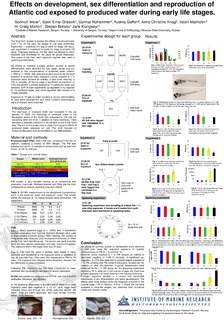Effects on development, sex differentiation and reproduction of Atlantic cod exposed to produced water during early life stages
Meier, Sonnich; Grøsvik, Bjørn Einar; Nyhammer, Gunnar; Geffen, Audrey J.; Knag, Anne Christine; Makhotin, Valeri; Morton, H. Craig; Boitsov, Stepan; Klungsøyr, Jarle
Conference object
Permanent lenke
http://hdl.handle.net/11250/116911Utgivelsesdato
2007-05-20Metadata
Vis full innførselSamlinger
- Posters [40]
Sammendrag
Two long term studies to assess the effects of produced water
(0.01-1 %) on the early life stages of cod were performed.
Experiment 1 examined the egg to early fry stage (90 days),
and experiment 2 examined the early fry stage to juvenile (78
days). Following exposure, the fish were transferred to clean
seawater and monitored for two years till sexual maturation.
One group of fish from each exposure regimen was used in
spawning experiments
No effects on hatching success, growth, survival or sexual
differentiation were detected for cod (eggs, larvae and fry)
exposed to low concentrations of produced water (dilution
1:1000 or 1:10000). Yolk sack larvae were found to be the most
sensitive to produced water exposure. Larvae exposed to 1 %
produced water showed an inability to start feed, resulting in
100 % mortality. At the fry stage a significant up-regulation of
VTG was shown in groups exposed to 1% produced water and
estradiol. CYP1A were significantly up-regulated in fry exposed
to 1% produced water, and down-regulated after exposure to
10 ppb estradiol.
Exposure to 10 ppb estradiol resulted in severe abnormalities
of male testis development and many different morphological
signs of intersex were observed.
Beskrivelse
Presented at SETAC Europe 17th Annual Meeting, 20-24 May 2007, Porto, Portugal
